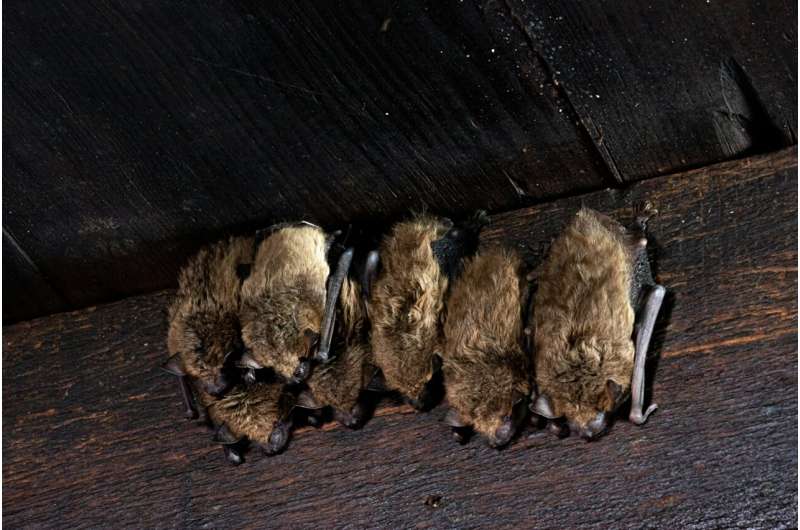This article has been reviewed according to Science X's editorial process and policies. Editors have highlighted the following attributes while ensuring the content's credibility:
fact-checked
peer-reviewed publication
trusted source
proofread
New method makes finding bat roosts easier for conservationists

A new algorithm is making it easier for ecologists and conservationists to find bat roost locations—reducing search areas by nearly 375 times their previous size. The technology combines microphone detector data with a bat movement model to identify optimal searching regions and predict roost locations.
The team, from Cardiff University and the University of Sussex, says their method can reduce vast search areas of over 3 km x 3 km, instead pinpointing potential roost locations within significantly smaller landscapes of 250 m x 250 m, roughly the size of eight football pitches.
Their findings, presented in Royal Society Open Science, could lead to labor savings of more than 90%, freeing up time for ecologists and conservationists to support bat populations and their habitats, which are protected under U.K. law.
The study's senior author Dr. Thomas E. Woolley, a Senior Lecturer at Cardiff University's School of Mathematics, said, "As well as being a protected species, bats are important to our environment—controlling pests, pollinating flowers and trees, and dispersing their seeds. To ensure their populations remain protected, growing and cared for, ecologists need to be able to find their roosts.
"But this is an extremely laborious process and involves searching large regions to find what are often small roosts. Our approach simplifies this needle in a haystack situation of roost identification, significantly reducing the search areas for professionals and volunteers alike working in wildlife conservation."
The work draws on the team's previous research developing a model from trajectory data on greater horseshoe bats to better understand how they move and engage with their environment.
The resulting algorithm uses the microphone detector data on where the greater horseshoe bats are and the movement model to predict where they came from.
The team tested the algorithm against known roost locations to measure its accuracy. The data came from six acoustic surveys conducted with recording devices specially calibrated to capture high-frequency bat calls at four different U.K. maternity roosts across Devon.
Dr. Woolley added, "Even when we don't accurately predict the location of a known roost, our algorithm identified areas close to roosts that were found later, emphasizing the reliability of our model."
The team plans to further develop the algorithm to incorporate terrain and weather data for even more precise predictions.
Professor Fiona Mathews from the University of Sussex and another of the paper's authors said, "Planning strategically to protect the network of roosts that bats need in a landscape is almost impossible.
"Previous research methods are very labor intensive with individuals reporting back to when they first hear bats of a particular species after sunset. These timings can then be used to track back to the roost.
"Our new method capitalizes on the fact that automated bat detectors are now widely available. We are looking forward to testing the methodology with other species this summer."
As well as streamlining the workloads of conservationists and ecologists, the team says the research may also encourage construction companies to employ sustainable building practices thereby reducing the environmental impact of site builds on surrounding habitats.
Dr. Woolley added, "Knowing where bat roosts are will help companies avoid building in these areas. This will support their building applications going through local authorities, which have a duty to maintain and nurture the environment."
More information: Lucy Henley et al, A simple and fast method for estimating bat roost locations, Royal Society Open Science (2024). DOI: 10.1098/rsos.231999
Journal information: Royal Society Open Science
Provided by Cardiff University


















